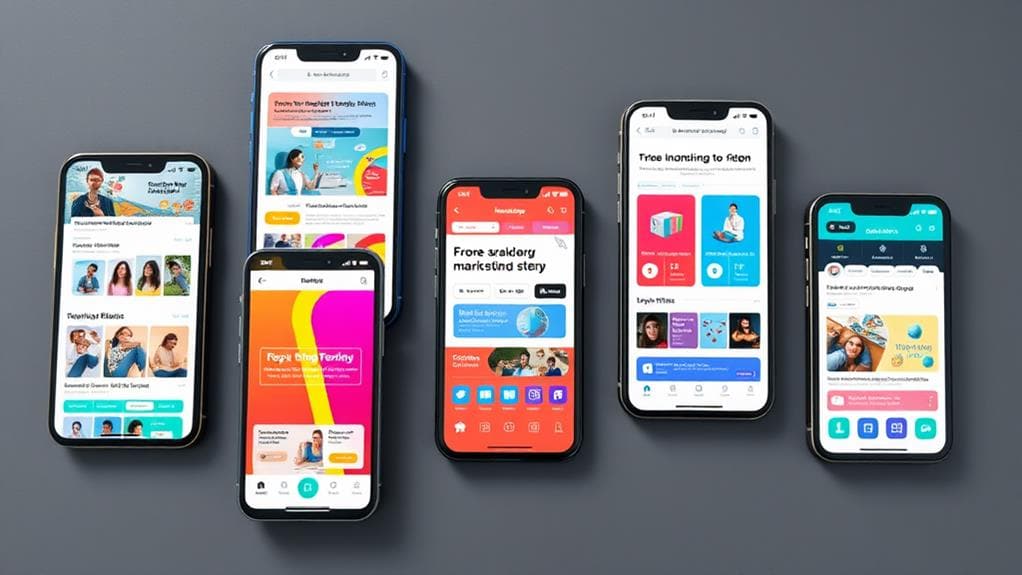How to Develop a Marketing Strategy for Mobile Users
To develop a marketing strategy for mobile users, start by understanding their behavior—80% exclusively access the internet via mobile. Optimize mobile performance by ensuring fast loading times, as a one-second delay can lead to a 7% drop in conversions. Create mobile-friendly content that is concise and visually engaging. Leverage mobile-specific channels, utilizing push notifications and social sharing to boost engagement. Implement responsive design for seamless user experiences across devices. Finally, continuously analyze mobile metrics to refine strategies. By focusing on these key elements, you'll enhance user satisfaction and drive conversions effectively. More insights await as you explore further.
Key Takeaways
- Analyze mobile user behavior to tailor content and improve engagement, focusing on short-form and visually appealing materials.
- Optimize mobile performance with fast loading times, utilizing techniques like image compression and caching strategies to retain users.
- Enhance user interface design with intuitive navigation, accessibility features, and clear visual hierarchy to facilitate interaction and satisfaction.
- Implement responsive design to ensure seamless user experiences across various devices, making content easily accessible and readable.
- Leverage mobile-specific marketing strategies, including personalized content, location-based promotions, and real-time engagement metrics for effective targeting.
Understand Mobile User Behavior

A notable percentage of consumers, approximately 80%, now access the internet exclusively through mobile devices, underscoring the importance of understanding mobile user behavior. As marketers look to craft effective strategies, it is essential to analyze mobile preferences shaped by device usage patterns and user demographics.
Mobile users exhibit unique behaviors, particularly in how they engage with content. Touch interactions dominate this landscape, greatly influencing app engagement and overall user experience. Users prefer apps for seamless navigation, allowing for quick access to information and streamlined purchase behavior.
Social media platforms, highly optimized for mobile consumption, play an essential role in shaping user interactions, with over 90% of users engaging via their smartphones.
Understanding mobile users also necessitates examination of content consumption trends. Short-form content such as videos and concise articles tends to perform well, reflecting users' preference for rapid information absorption.
Additionally, mobile users exhibit varying behaviors based on demographics; younger audiences, for instance, are more inclined to explore new apps and participate in social media engagements, while older demographics may prioritize usability and essential features.
Ultimately, recognizing these mobile preferences enables marketers to tailor their approaches effectively, creating engaging user experiences that resonate with their target audiences. By leveraging insights around touch interactions, social media usage, and distinct purchase behaviors, brands can enhance their visibility and foster brand loyalty in an increasingly mobile-centric landscape.
Optimize for Mobile Performance
Optimizing for mobile performance is essential for enhancing user engagement and retention.
Prioritizing fast loading times, refining user interface design, and implementing responsive layouts can greatly improve the overall mobile experience.
Research indicates that a one-second delay in loading time can lead to a 7% reduction in conversions, underscoring the importance of speed and usability in mobile marketing strategies.
Prioritize Fast Loading Times
During a time when attention spans are dwindling, fast loading times on mobile devices are not just a luxury—they are a necessity. Research indicates that 53% of mobile users will abandon a site that takes over three seconds to load. This stark reality emphasizes the importance of mobile optimization techniques that prioritize speed.
Implementing robust caching strategies, optimizing images, and minimizing scripts can greatly enhance loading times. By using Content Delivery Networks (CDNs), businesses can reduce latency and deliver content more effectively. These techniques not only improve performance but also greatly boost user engagement strategies. Enhanced speed leads to better user experiences, fostering loyalty and increasing conversion rates.
Moreover, Google's mobile-first indexing prioritizes mobile loading times in search rankings, making fast loading an imperative for visibility. Brands that focus on speed can secure a competitive edge, attracting users who value efficiency and seamless browsing.
Enhance User Interface Design
Creating an intuitive user interface is paramount for mobile performance, as it directly influences user engagement and satisfaction. A well-designed UI enhances usability, ensuring that users have a seamless experience while traversing your application or website.
To achieve peak mobile performance, consider integrating essential elements that promote accessibility and facilitate user interaction.
- Mobile accessibility features: Incorporate tools that cater to users with disabilities, such as voice commands, screen readers, and adjustable text sizes.
- Touch gesture optimization: Design touch targets that are easy to interact with, minimizing errors and enhancing overall user experience.
- Streamlined navigation: Use a minimalist approach, making key features easily reachable to prevent user frustration.
- Consistent visual hierarchy: Utilize color contrast and typography that guide users through your content, allowing for quicker decision-making.
Implement Responsive Layouts
Responsive layouts are fundamental for guaranteeing that mobile users enjoy a seamless and engaging experience across various devices. By employing flexible grids, designers can create a fluid framework that adapts to varying screen sizes, allowing for the ideal presentation of content.
Utilizing adaptive images guarantees that graphics load efficiently, enhancing performance without compromising quality. Effective viewport settings are vital for establishing how your content appears on different devices.
Coupled with media queries, these settings allow for sophisticated adjustments based on device orientation and screen resolution. Additionally, prioritizing mobile typography guarantees text is legible and aesthetically pleasing, drawing users into your content.
Thoughtfully designed touch targets enhance usability, allowing users to navigate effortlessly. A clear content hierarchy guides visitors through important information, aligning with user feedback to improve overall engagement.
Incorporating accessibility features assures that your site is inclusive, meeting the diverse needs of all users. Ultimately, a commitment to responsive layouts not only elevates user experience but also aligns with the increasing demand for freedom in mobile browsing.
Embrace these practices to drive conversions and create lasting impressions in an ever-evolving digital landscape.
Design Mobile-Friendly Content

To effectively engage mobile users, content design must prioritize a simplified navigation experience, ensuring effortless access to information.
Additionally, optimizing loading speed can greatly reduce bounce rates, enhancing user retention and satisfaction.
Incorporating engaging visuals not only captures attention but also enhances information retention, making the overall mobile experience more impactful.
Simplify Navigation Experience
As mobile users increasingly dominate the digital landscape, guaranteeing a streamlined navigation experience becomes imperative for effective content engagement.
A well-structured mobile navigation elevates user satisfaction and retention rates. Clarity and simplicity should be your guiding principles when designing for mobile platforms.
To create a navigation experience that resonates with users, consider implementing the following strategies:
- Utilize intuitive gestures: Leverage swiping, tapping, and pinching to enhance interaction, making navigation feel effortless.
- Incorporate streamlined menus: Prioritize essential content using concise and well-organized menus to eliminate clutter.
- Design for thumb-friendly accessibility: Ascertain buttons and links are within easy reach, accommodating users on-the-go.
- Adapt layouts for vertical scanning: Since users tend to scroll vertically, design pages that facilitate quick content discovery.
Optimize Loading Speed
Recognizing the critical role of loading speed in user experience, optimizing content for mobile is essential in today's fast-paced digital environment. With data revealing that 53% of mobile users abandon sites that take longer than three seconds to load, the stakes are high for marketers aiming for success. Implementing effective loading techniques can greatly improve engagement and conversion rates.
Start by employing responsive design, ensuring that your site adapts seamlessly to different screen sizes. Additionally, utilizing accelerated mobile pages (AMP) can notably enhance loading speed, delivering lightweight versions of your content to mobile users.
Compressing images and leveraging browser caching are also critical mobile optimization strategies that can reduce load times without compromising quality. Moreover, minimizing redirects and using asynchronous loading for JavaScript can further streamline performance.
Regularly monitor your site's speed using tools such as Google PageSpeed Insights, allowing for ongoing optimization based on user feedback and performance metrics.
In an era where attention spans are fleeting, prioritizing loading speed not only enhances user experience but also empowers businesses to thrive in a competitive landscape, granting mobile users the freedom to engage effortlessly with your brand.
Use Engaging Visuals
Engaging visuals can greatly elevate the mobile user experience, capturing attention and conveying messages effectively. In a world where first impressions matter, your content must resonate instantly with your audience.
Leveraging tools like visual storytelling, interactive graphics, and mobile infographics can create immersive visuals that appeal to users' preferences.
To enhance your mobile marketing strategy, consider the following elements:
- Visual hierarchy: Prioritize information to guide users seamlessly through your content.
- Color psychology: Use colors that evoke emotions appropriate for your brand and message.
- Animated content: Capture attention and maintain engagement with dynamic visual elements.
- Visual consistency: Guarantee a uniform aesthetic across platforms to foster brand recognition and trust.
These strategies not only improve user engagement but also facilitate better information retention.
By creating a coherent experience that promotes freedom of exploration, you empower mobile users to connect with your message in a more meaningful way.
Leverage Mobile-Specific Channels
Harnessing the power of mobile-specific channels is essential for brands aiming to establish a meaningful connection with today's on-the-go consumers. With approximately 50% of global web traffic originating from mobile devices, it is imperative for companies to utilize mobile advertising effectively and engage users where they spend their time.
Social media platforms, with their mobile-friendly interfaces, offer lucrative opportunities for brands to reach a wider audience and promote their products or services in an engaging manner. Targeting mobile users through social media enhances brand visibility while creating personalized experiences.
Brands can leverage video content, stories, and ads optimized for mobile views to capture attention quickly and communicate their message effectively. According to a report from Hootsuite, 98% of social media users access these platforms via mobile devices—an indicator of the shift toward mobile-centric engagement strategies.
Moreover, utilizing mobile-specific channels allows for real-time interaction with consumers, fostering a dynamic relationship that adapts to their feedback and preferences. Incorporating mobile advertising into this mix enables brands to create targeted campaigns based on user behavior, interests, and demographics, thereby increasing conversion rates.
Use Location-Based Marketing

Location-based marketing is increasingly essential for brands seeking to connect with consumers in a targeted manner. By utilizing location analytics, businesses can understand their audience's behaviors, preferences, and demographics, allowing for effective user segmentation. This knowledge empowers brands to engage in proximity marketing and launch geofencing campaigns that deliver relevant messages as consumers enter specified locations.
The right location-based marketing strategy can involve several tactics, including:
- Mobile Check-Ins: Encourage users to check in at your location, providing opportunities for loyalty rewards.
- Personalized Promotions: Offer tailored discounts to consumers based on their proximity to your business.
- Local Partnerships: Collaborate with nearby businesses to reach a wider audience.
- Real-Time Targeting: Utilize data to send offers or notifications to potential customers as they shop nearby.
Employing these strategies allows brands to create meaningful connections with consumers. For instance, localized promotions can greatly increase foot traffic during peak hours, while personalized messaging enhances customer satisfaction.
Additionally, engaging in local partnerships can expand reach and brand visibility, attracting consumers seeking convenience. As technology continues to evolve, brands must prioritize location-based marketing as a key component of their overall mobile strategy.
Implement Responsive Design
As consumers increasingly rely on their mobile devices for shopping, implementing responsive design becomes essential for brands aiming to enhance user experience. Responsive design guarantees that websites automatically adjust to fit various screen sizes, providing a seamless browsing experience across platforms—from smartphones to tablets.
In the domain of mobile design trends, businesses must stay ahead by adopting elements that cater to their audience's needs. Not only does responsive design accommodate different devices, but it also optimizes images, text, and features for clarity and ease of use.
Research indicates that 53% of mobile users abandon sites that take longer than three seconds to load, highlighting the importance of not just responsiveness but speed as well.
User accessibility is a critical component within responsive design. When websites are designed to be accessible, they allow users of all abilities to interact with content efficiently. This can include optimizing navigation for finger-tapping, guaranteeing sufficient contrast between text and background, and providing alternative text for images.
Moreover, implementing a mobile-first approach in design thinking aligns closely with modern consumer behavior. A significant 61% of users are less likely to return to a website that isn't mobile-friendly.
Prioritize User Experience

Ninety-one percent of consumers are more likely to return to a website after a positive user experience, making it imperative for brands to prioritize user experience (UX) in their mobile marketing strategies. As mobile users demand seamless interactions, businesses must focus on guaranteeing mobile accessibility and incorporating user feedback into their design processes.
A well-crafted UX not only fosters loyalty but also drives conversions, as satisfied users are more inclined to engage.
To create a compelling mobile experience, brands should consider the following elements:
- Responsive Navigation: Simplify menus and guarantee easy access to essential features.
- Fast Loading Times: Optimize images and scripts to deliver instant gratification and prevent user frustration.
- Intuitive Design: Implement clear calls-to-action and a logical flow to guide users through their journey effortlessly.
- Regular User Feedback: Encourage insights from users and adapt accordingly, creating an evolving platform that meets their needs.
When prioritizing UX, brands gain valuable insight into how users interact with their content, fostering a community that feels heard and valued. Incorporating user feedback leads to continuous improvement and helps align the brand's offerings with consumer expectations.
In a mobile-driven world, neglecting user experience can result in lost opportunities. As a result, investing in high-quality UX is not merely an option, but a necessity for any brand looking to thrive in today's competitive landscape.
Analyze Mobile Marketing Metrics
Understanding mobile marketing metrics is fundamental for businesses aiming to refine their strategies and enhance user engagement. Accurate measurement allows marketers to assess conversion rates, identify areas needing improvement, and ultimately drive more effective mobile experiences.
By leveraging mobile analytics, companies can gain insights into user behavior, such as interaction patterns and retention rates. A/B testing emerges as a powerful method to improve campaign performance. By comparing different variations of mobile content, businesses can determine which approach resonates better with their target audience.
This process fosters precise user segmentation, enabling marketers to tailor messages that closely align with user preferences. Effective campaign tracking is essential for monitoring the success of marketing efforts in real-time. Metrics relating to mobile accessibility, such as page load times and mobile-friendly design, directly impact user engagement and satisfaction.
Additionally, content personalization plays an important role in engaging users—customized experiences increase the likelihood of conversion by providing relevant offers and information tailored to individual interests. Incorporating social sharing and push notifications further enhances user engagement.
Social sharing expands a brand's reach, while push notifications allow timely communication, keeping users informed and encouraging interactions. Tracking these metrics helps maintain a user-centric approach, facilitating ongoing improvements in mobile marketing strategies.
Ultimately, analyzing these metrics empowers businesses to achieve greater success by understanding user behavior and adapting their strategies for the best performance.
Stay Updated With Trends

Staying abreast of evolving mobile marketing trends is essential for businesses looking to maintain a competitive edge. In the fast-paced world of mobile technology, being informed about the latest developments enables brands to resonate with their target audience effectively.
Regularly conducting market research and competitor analysis helps identify shifts in user demographics and device preferences that can shape advertising strategies.
To navigate the dynamic landscape successfully, businesses should focus on the following key areas:
- Social Media Trends: Monitor the latest platforms and engagement styles to capture audience attention.
- App Innovations: Stay updated with advancements in app features that enhance user experience and interaction.
- Content Consumption: Analyze how users prefer to consume content—whether through short videos, interactive media, or immersive experiences.
- Engagement Metrics: Evaluate the performance of marketing campaigns based on user interactions to refine strategies continuously.
Understanding these trends not only helps to tailor offerings uniquely but also fosters loyalty among customers who appreciate brands that keep up with evolving tastes.
As advertising strategies pivot towards more personalized experiences, integrating new insights from social media analytics and device usage will guarantee that your marketing initiatives remain relevant.
Embracing these trends empowers businesses to craft compelling narratives that resonate with mobile users, ultimately driving engagement and conversions.
In this rapidly changing environment, sharing knowledge and insights will keep you informed and ahead of the curve.
Frequently Asked Questions
How Can I Identify My Mobile Target Audience?
Identifying your mobile target audience requires a systematic approach.
Start with demographic segmentation, analyzing factors such as age, gender, location, and income. This data helps in crafting a user persona that reflects your ideal customer.
Engage in surveys and analyze mobile usage patterns to gather insights into behaviors and preferences.
What Tools Can Help Me Analyze Mobile User Behavior?
To effectively analyze mobile user behavior, incorporating robust analytics tools is essential.
Platforms such as Google Analytics, Mixpanel, or Amplitude enable businesses to track user engagement metrics, offering insights into app usage patterns and user preferences.
These tools help identify key performance indicators, uncovering trends in user interactions and engagement levels.
How Often Should I Update My Mobile Marketing Strategy?
In the fast-evolving digital landscape, 79% of consumers say they are more loyal to brands that offer a personalized experience on mobile.
Consequently, updating your mobile marketing strategy should be a continual process, ideally quarterly or semi-annually, to align with emerging mobile trends and shifting user preferences.
Regular assessments allow for agile adaptations that enhance user engagement, ensuring your brand remains relevant and competitive in a dynamic marketplace.
Are There Specific Regulations for Mobile Marketing Campaigns?
Mobile marketing campaigns are subject to specific regulations focused on consumer protection.
Key considerations include adherence to mobile data privacy laws, which dictate how consumer data can be collected and used.
Additionally, SMS marketing guidelines require explicit consent from recipients before messages are sent, ensuring transparency and respect for individual freedoms.
Companies must remain vigilant in monitoring these regulations to maintain compliance and foster trust among their mobile audience.
How Do I Measure Mobile ROI Effectively?
Effectively measuring mobile ROI requires a multifaceted approach focused on mobile conversion rates and tracking metrics.
Key performance indicators (KPIs) such as click-through rates, engagement levels, and customer acquisition cost should be analyzed to assess the impact of mobile campaigns.
Utilizing tools like Google Analytics and mobile tracking software will provide actionable insights, enabling marketers to refine their strategies and optimize resources.
This data-driven approach empowers businesses to capitalize on mobile opportunities confidently.
Conclusion
In the vast garden of digital marketing, cultivating a strategy tailored for mobile users resembles nurturing delicate blooms. By understanding user behavior, optimizing performance, and designing content that flourishes on mobile devices, marketers can create an ecosystem where engagement blossoms. Utilizing location-based tactics and responsive design further enriches this growth. Continuous analysis of mobile metrics guarantees that the garden thrives amid changing seasons, ultimately leading to a vibrant landscape of customer connections and brand loyalty.




